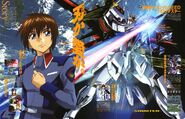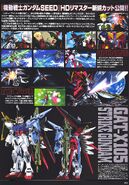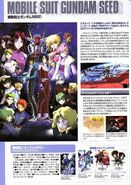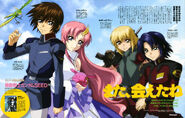"Anime" is not in the list (Manga, Novel, Game, Movie, OVA, Variation, Stage Play, Documentary, TV Series, Audio Drama, ...) of allowed values for the "Media" property.
Mobile Suit Gundam SEED (or "Gundam SEED") is an anime television series from Japan. It is a part of the Gundam franchise that started in 1979, but takes place in an alternate universe called the Cosmic Era. The series has 50 episodes, aired in Japan from October 5, 2002 to September 27, 2003 at 6:00 p.m. on the JNN TV stations (Tokyo Broadcasting System (TBS TV), Mainichi Broadcasting System (MBS TV, producing TV station), etc.). The series had finished remastering in High-Definition for it's 10th year anniversary, omitting two recap episodes.
Overview
Directed by Mitsuo Fukuda (Future GPX Cyber Formula and Gear Fighter Dendoh), the series is the first set in the Cosmic Era universe. This series begins with a war between Earth and the colonies that is similar to the One Year War of the original Gundam series with certain traditional elements from New Mobile Report Gundam Wing and After War Gundam X. On one side is the Earth Alliance, and on the opposite is the space colonies that form ZAFT (Zodiac Alliance of Freedom Treaty). Mankind is divided over human genetic engineering, with normal humans known as 'Naturals' and the genetically altered humans known as 'Coordinators'. Like the original series, ZAFT has a head start on mobile suit design, the Earth Alliance quickly catches up with its five prototype Gundam’s. With ZAFT having stolen four of the prototypes, young pilot Kira Yamato takes the Strike Gundam and is forced to fight his old friend Athrun Zala. Little do they know that there are sinister forces at work that go far beyond their worst nightmares...
Themes and reactions
The series was widely acclaimed upon release,[1][2] and has left a great legacy upon the otaku community of Japan and abroad. Some of the major characters can still be seen in the Top 10 favorite character lists of Newtype magazine,[3] and the merchandise sold in the millions.[4]
The series was intended to be the 21st Century Gundam[5] updated for a new generation of fans, with other elements from previous series added into the mix. The similarities between the original Mobile Suit Gundam and this series are by far the most numerous. To fit the tastes of 21st century viewers, themes based on the elements surrounding present day situations were incorporated namely the 9/11 attacks, Fukuda speaks of an unbroken cycle of hatred since Christ's death with justice on both sides (Muslim and non-Muslim).[6] The series primarily focused on the interpersonal relationships between the characters,[6][7] resulting in many layered romantic friendships. The series is guided by the traumatic friendship between pilots Kira Yamato and Athrun Zala.
The inclusion of issues such as racism, with desires of genocide, further updated the series and provided food for thought as well as social commentary. The genetically altered Coordinators provide a vision for the future in a world fraught with talk of GM food and cloning.
Airing information
The series is licensed by Bandai Entertainment, and was released on DVD in North America in uncut bilingual format. An edited version of the English dub premiered during the Toonami block at 10:30 p.m. on Saturday nights, it was pushed back to 1:00 am on Friday nights starting with Phase 27 due to below average ratings.Template:Cite
The majority of the series was aired with a TV-Y7, apparently, at the insistence of Bandai who were desperately trying to push the new Gundam SEED toy line. However, since most retailers had stopped carrying the Gundam line due to over-saturation from the G Gundam series, this soon became a lost cause. Only the final episode was given the TV-PG-SV rating rather than the usual TV-Y7 rating.
Things that were edited out on Cartoon Network include mature content (ex. most references to the sexual relationship between Kira and Flay—though the initial scene presenting this was left partially intact); scenes of intense combat violence (ex. almost all shots of pilots, including main characters, in their cockpits before having their machines destroyed); cold-blooded or brutal murders that are non-mobile suit related (ex. Siegel Clyne getting shot by ZAFT soldiers loyal to Rau Le Creuset and Patrick Zala); all references to the fact that the Living CPUs need to take performance enhancing drugs; and most notoriously, handguns being sloppily and inconsistently transformed into neon-colored lasers, dubbed "Disco Guns" by fans, for the majority of the show's run. Also, there was little to no use of the words "kill" or "die" in the middle of the series airing. Since most of the series had been edited by Williams Street before broadcast, Cartoon Network changed very little in terms of content allowance. However, the airings of the final two episodes were left mostly unedited, with only a few elements being affected—namely the guns used by Azrael, Patrick Zala, and one of the ZAFT soldiers (which was given neon-colored lights in certain but not all of the image frames), airbrushing the naked Flay's body in the final episode to avoid showing her cleavage, reducing the amount of blood shown, editing the character's lines; to remove either inappropriate language or controversial lines, and the removal or altering of flashbacks of graphic assassinations. The Canadian version debuted on YTV's Bionix block in September 2004 at 9:30 p.m. where it got a better reception and aired comparatively uncut, with almost all of the material listed above intact.
In Japan, it occupied the Saturday 6 p.m. timeslot on MBS and TBS, widely considered a prime timeslot; the anime and its subsequent successor to the timeslot (Full Metal Alchemist) went on to do very well.
In the Philippines, the show was aired on ABS-CBN last December 20, 2004. First shown on the 6 pm primetime block on Weekdays (Mondays-Fridays), it was later moved to the 5:30 pm slot on the same day frame until it's End last March 4, 2005. Currently, it airs on ABS-CBN's Cable Anime Channel, Hero TV every Friday at 10:30 am, 5:30 pm and 11:30 pm, and in Cartoon Network Philippines every Saturday and Sunday at 10:30 pm (double episodes) (all times in Philippine Standard Time [GMT+8])
Adaptations, Spin-offs & Sequels
A three-part compilation of the TV series has been released as Gundam SEED: Special Edition. The English manga, authored by Masatsugu Iwase, is published in North America by Del Rey Manga and in Singapore by Chuang Yi, while Gundam SEED Astray, a spin-off of Gundam SEED, is published in North America by Tokyopop.
An adaptation of the TV series, authored by Mizuho Takayama, was originally as supplement of Comic BomBom. This version comes with folding color posters of the Mobile Suits, and a bonus Gundam SEED Destiny episode 0 comic. The stories were eventually published into 2 volumes by Kodansha. The 2-volume version is available in Chinese, published by Rightman Publishing Ltd. in Hong Kong.
The TV series was also turned into a series of novels by Riu Koto, published by Kadokawa Shoten.
Also running with the series was a series of manga called Mobile Suit Gundam SEED Astray that told a side-story to the anime series. This proved popular enough to generate two more side-stories: Mobile Suit Gundam SEED Astray R and Mobile Suit Gundam SEED X Astray.
On July 6, 2004 the sequel to Mobile Suit Gundam SEED, Mobile Suit Gundam SEED Destiny, was announced after over a month of rumors. It started airing in Japan on October 2004 on the network Mainichi Broadcasting System and ran until October 1, 2005. A third Gundam SEED production, Mobile Suit Gundam SEED C.E. 73:STARGAZER, an ONA side-story to Destiny, is currently being streamed on Bandai Channel. A film was recently announced to complete the trilogy.
SEED is currently being rereleased after a HD remastering project in honor its 10th anniversary, some scenes are redrawn, effects such as beam weapon shots touched up for larger TV's (previously would be a couple of bars of solid color now have extra fine details and graduated color changes across the beam), some scenes are cropped for widescreen while others (like computer console displays of text or graphics) have extra detail added to the sides (such as the edges of the console itself) to make them into widescreen aspect without the console content loss which would occur from cropping.
Cast & Crew
One striking fact of the series is that the voices of characters, both major and minor, were done by many veteran seiyu. The cast list reads like a Who's Who of Japanese voice actors and actresses . This is also carried over to the sequel, Gundam SEED Destiny. While there has always been scrutiny over the dubbing of many anime series, the mispronunciation of several character names in the English dubbing has angered many die-hard Gundam SEED fans.Template:Cite
Cast
- Athrun Zala - Akira Ishida (Japanese), Samuel Vincent (English), Louie Paraboles (Tagalog)
- Cagalli Yula Athha - Naomi Shindou (Japanese), Vanessa Morley (English)
- Clotho Buer - Hiro Yuuki (Japanese), Ted Cole (English)
- Dearka Elsman - Akira Sasanuma (Japanese), Brad Swaile (English), Bernie Malejana (Tagalog)
- Martin DaCosta - Akira Sasanuma (Japanese), Brian Dobson (English)
- Ezalia Joule - Kotono Mitsuishi (Japanese),
- Haro - Kotono Mitsuishi (Japanese), Tabitha St. Germain (English)
- Murrue Ramius - Kotono Mitsuishi (Japanese), Lisa Ann Beley (English)
- Flay Allster - Houko Kuwashima (Japanese), Tabitha St. Germain (English)
- Natarle Badgiruel - Houko Kuwashima (Japanese), Sarah Johns (English)
- Kira Yamato - Souichirou Hoshi (Japanese), Matt Hill (English), Michael Punzalan (Tagalog)
- Lacus Clyne - Rie Tanaka (Japanese), Chantal Strand (English)
- Miguel Aiman - Takanori Nishikawa (T.M. Revolution) (Japanese), Tony Sampson (English)
- Mu La Flaga - Takehito Koyasu (Japanese), Trevor Devall (English)
- Nicol Amarfi - Mami Matsui/Romi Paku (Special Edition) (Japanese), Gabe Khouth (English)
- Orga Sabnak - Joshida Ryohei (Japanese), Andrew Toth (English)
- Rau Le Creuset - Toshihiko Seki (Japanese), Mark Oliver (English)
- Shani Andras - Shunichi Miyamoto (Japanese), Richard Ian Cox (English)
- Yzak Joule - Tomokazu Seki (Japanese), Michael Adamthwaite (English), Jefferson Utanes (Tagalog)
- Andrew Waltfeld - Ryotaro Okiayu (Japanese), Brian Drummond (English)
- Aisha - Vivian Hsu/ Fumi Hirano (Special Edition) (Japanese),
- Muruta Azrael - Nobuyuki Hiyama (Japanese), Andrew Francis (English)
- Tolle Koenig - Takayuki Inoue (Japanese), Richard Ian Cox (English)
- Arnold Neumann - Isshin Chiba (Japanese), Philip Pacaud (English)
- Ledonir Kisaka - Isshin Chiba (Japanese), Adam Henderson (English)
- Kuzzey Buskirk - Yasuhiro Takato (Japanese), Keith Miller (English)
- Romero Pal - Yasuhiro Takato (Japanese), Brendan Van Wijk (English)
- Patrick Zala - Kinryu Arimoto (Japanese), Andrew Kavadas (English), Bernie Malejana (Tagalog)
- Miriallia Haw - Megumi Toyoguchi (Japanese), Anna Cummer (English)
- Sai Argyle - Tetsu Shiratori (Japanese), Bill Switzer (English), Jefferson Utanes (Tagalog)
- Eileen Canaver - Lisa Ann Beley (English)
- Uzumi Nara Athha - John Novak (English)
- Siegel Clyne - Don Brown (English)
- Reverend Malchio - Brian Drummond (English)
- Birdy (Torii),- Tabitha St. Germain (English)
- Koopman - Scott McNeil (English)
- Gerard Garcia - Scott McNeil (English)
- Yuri Amalfi - Ted Cole (English)
- Dalida Lolaha Chandra II - Simon Hayama (English)
- Kojiro Murdoch - Ward Perry (English)
- Erica Simmons - Sharon Alexander (English)
- Mayura Labatt - Rebecca Shoichet (English)
- Aisha - Saffron Henderson (English)
- Asagi Caldwell - Jocelyne Loewen (English)
- Capt. Fredrik Ades - Michael Dobson (English)
- Col. William Sutherland - Ron Halder (English)
- Lacus' singing voice - Jillian Michaels (English)
- Music Composer - Toshihiko Sahashi
Openings, Endings and Insert Songs
Openings
- INVOKE by T.M.Revolution (ep. 1-13) (Toonami Broadcast: episode 1-26), (YTV Broadcast: 1-50)
- Moment by Vivian or Kazuma (ep. 14-26)
- Believe by Nami Tamaki (ep. 27-40)
- Realize by Nami Tamaki (ep. 41-50)
Endings
- Anna ni Issho Datta no ni (あんなに一緒だったのに; We were so together, but) by See-Saw (ep. 1-26)
- RIVER by Tatsuya Ishii (ep. 27-39)
- FIND THE WAY by Mika Nakashima (ep. 40-50) (HD remaster ep. 45, insert) (HD remaster ep. 48)
- Distance by FictionJunction (HD remaster ep. 27?-47)
Insert Songs
- Akatsuki no Kuruma (暁の車; Wheels of Dawn) by FictionJunction YUUKA (ep. 24, 32, 40)
- Anna ni Issho Datta no ni (We were so together, but) by See-Saw (episode 28)
- Meteor by T.M. Revolution (ep. 26, 29, 35, 47)
- Mizu no Akashi (水の証; Token of Water) by Rie Tanaka (English version Jillian Michaels) (ep. 36 & 41)
- Shizuka na Yoru ni (静かな夜に; In the Quiet Night) by Rie Tanaka (English version Jillian Michaels) (episodes 7-9, 14, 20)
- FIND THE WAY by Mika Nakashima (ep. 46)
Episodes
See also: List of Gundam SEED episodes
| # | Episode Title | Japanese Airdate | English Airdate |
|---|---|---|---|
| 1 | False Peace | 5 October 2002 | 17 April 2004 |
| 2 | Its Name: Gundam | 12 October 2002 | 24 April 2004 |
| 3 | Collapsing Land | 19 October 2002 | 1 May 2004 |
| 4 | Silent Run | 26 October 2002 | 8 May 2004 |
| 5 | Phase Shift Down | 2 November 2002 | 15 May 2004 |
| 6 | The Vanishing Gundam | 9 November 2002 | 22 May 2004 |
| 7 | The Scar of Space | 16 November 2002 | 29 May 2004 |
| 8 | The Songstress of The Enemy Forces | 23 November 2002 | 5 June 2004 |
| 9 | The Fading Light | 30 November 2002 | 12 June 2004 |
| 10 | Crossroads | 7 December 2002 | 19 June 2004 |
| 11 | The Awakening Sword | 14 December 2002 | 26 June 2004 |
| 12 | Flay's Decision | 21 December 2002 | 3 July 2004 |
| 13 | Stars Falling in Space | 28 December 2002 | 10 July 2004 |
| 14 | Within Endless Time | 4 January 2003 | 17 July 2004 |
| 15 | The Respective Solitudes | 11 January 2003 | 24 July 2004 |
| 16 | Burning Sandstorm | 18 January 2003 | 31 July 2004 |
| 17 | Cagalli Returns | 25 January 2003 | 7 August 2004 |
| 18 | Payback | 1 February 2003 | 14 August 2004 |
| 19 | Fangs of the Enemy | 8 February 2003 | 21 August 2004 |
| 20 | On a Calm Day | 15 February 2003 | 28 August 2004 |
| 21 | Beyond the Clouds of Sand | 22 February 2003 | 4 September 2004 |
| 22 | The Sea Dyed Red | 1 March 2003 | 11 September 2004 |
| 23 | Fateful Encounter | 8 March 2003 | 18 September 2004 |
| 24 | War for Two | 15 March 2003 | 2 October 2004 |
| 25 | The Land of Peace | 22 March 2003 | 9 October 2004 |
| 26 | Moment | 29 March 2003 | 16 October 2004 |
| 27 | Endless Rondo | 12 April 2003 | 23 October 2004 |
| 28 | Kira | 19 April 2003 | 30 October 2004 |
| 29 | The Turning Point | 26 April 2003 | 6 November 2004 |
| 30 | Flashing Blades | 3 May 2003 | 13 November 2004 |
| 31 | Grieving Skies | 10 May 2003 | 20 November 2004 |
| 32 | In the Promised Land | 17 May 2003 | 27 November 2004 |
| 33 | Gathering Darkness | 24 May 2003 | 4 December 2004 |
| 34 | Seen and Unseen | 31 May 2003 | 11 December 2004 |
| 35 | The Descending Sword | 7 June 2003 | 18 December 2004 |
| 36 | In the Name of Justice | 14 June 2003 | 7 January 2005 |
| 37 | Divine Thunder | 21 June 2003 | 14 January 2005 |
| 38 | Decisive Fire | 28 June 2003 | 21 January 2005 |
| 39 | Athrun | 5 July 2003 | 28 January 2005 |
| 40 | Into the Dawn Skies | 12 July 2003 | 4 February 2005 |
| 41 | Trembling World | 19 July 2003 | 11 February 2005 |
| 42 | Lacus Strikes | 26 July 2003 | 18 February 2005 |
| 43 | What Stands in the Way | 2 August 2003 | 25 February 2005 |
| 44 | Spiral of Encounters | 9 August 2003 | 4 March 2005 |
| 45 | The Opening Door | 16 August 2003 | 11 March 2005 |
| 46 | A Place for the Soul | 30 August 2003 | 18 March 2005 |
| 47 | The Nightmare Reborn | 6 September 2003 | 25 March 2005 |
| 48 | Day of Wrath | 13 September 2003 | 1 April 2005 |
| 49 | The Final Light | 20 September 2003 | 8 April 2005 |
| 50 | To a Future that Never Ends | 27 September 2003 | 15 April 2005 |
Trivia
- In episode 16 ("The Burning Desert Sands"), it is made very clear that the main character Kira Yamato and his love interest Flay Allster had sex sometime between episodes 15 and 16. This scene gave parents in Japan a scare and caused a good deal of controversy at the time. The directors were punished for this scene. However, when the Gundam SEED Special Edition was released, it was revealed that the two indeed had sex.
- Cagalli, Flay and Lacus, the three female leads of the series, only ever exchange 1 line of dialogue to each of the other two throughout the series' 50-episode run.
- In episodes 19 or 20 when Cagalli finished the flight simulator the screen read "Lanking" and "Kagali"
- In episode 32 ("In the Promised Land"), the investigation report Captain Sutherland holds in his hands at JOSH-A, Alaska shows Kira to hold the rank of Lieutenant, he actually holds the rank of Ensign. The discharge paper given to Kira, which he tears up, identifies his rank as "Second Lieutenant", which is equivalent to "Ensign".
- The word 'Gundam' is only used by four characters over the course of the entire series: Kira Yamato, who just uses the acronym for Strike Gundam's OS, Kuzzey Buskirk shortly after Kira's initial sortie in the Strike, when he says "This 'Gundam' thing is awesome" Murrue Ramius and Lacus Clyne, the latter of whom only uses it twice: When Kira sees the Freedom, he mutters "Gundam...", in response to which Lacus explains that "actually, it's the ZGMF-X10A Freedom. But I like 'Gundam'. It sounds strong." and later she says it to Athrun, when he receives the Justice. Mu La Flaga also used the word once, when asking Kojiro Murdoch why Kira called it that.
- Many Mobile Suits in the Cosmic Era timeline (especially Ace-Suits) have the small 'V' on their frame. Mobile Suits developed by the Earth Alliance have the 'V' in the same location as the RX-78-2 Gundam, the crotch, while ZAFT Mobile Suits tend to have it on the torso instead. The 'V' is a direct reference to the UC Timeline, where all Mobile Suits based on Gundam have the 'V'-shaped crest (up until Char's Counterattack, at least).
- Along with its sequel, Gundam SEED Destiny, Gundam SEED is the Gundam series that scored the most brilliant achievements in Animage's Anime Grand Prix. It won the 1st place in 2002, 2004 and 2005, and selected as the runner up in 2003 and 2006. Other Gundam series that come up to Gundam SEED's achievements are the original Mobile Suit Gundam (won the 1st place twice), followed by Zeta Gundam, Gundam ZZ, Gundam Wing and Gundam 00 (each won the second place once).
- Gundam Seed, as well as its sequel and expanded universe, shows many references and nods to another popular sci-fi series, Star Trek. The show itself, can be compared to the classic Star Trek episode Space Seed, as well as its follow up movie Wrath of Khan. Both series' central themes revolve around the creation of a gentetically altered and superior race of humans. This "superiority" of the new race of humans causes fear and misunderstanding amongst normal humans. In both series, this friction ends with the banishment of the new humans to outer space. Also, both the followers of Khan, and the Coordinator's ultimate weapon were called Genesis.
- The relationship between Mu La Flaga, Murrue Ramius, and Natarle Badgiruel is much like the relationship of Star Trek's Power Trio of Captain Tiberius Kirk, Dr. Leonard McCoy, and Spock, respectively. Rau Le Crueset can also be compared to that of Khan.
- Gundam SEED is actually quite infamous concerning its roles in the various Super Robot Wars games. Its first appearance, in Super Robot Wars Alpha 3, was known for the fact that it was forced to be put in by Bandai, apparently scuttling plans for Gundam Sentinel to be used. Super Robot Wars W is also known for the fact that, by playing the game the right way, you can actually save almost everyone who should have died in the original series.
- Gundam SEED is one of the few series to not be named for one of the Gundams shown in it.
- Gundam SEED is the first Gundam series to have four different title sequences instead of two. Every subsequent series until Gundam Build Fighters would do this as well.
- A college student in China, Yao Lijin, won a National Essay Writing contest in 2014 for an essay comparing Gundam SEED to the Sino-Japan relations, how it opened young eyes to thinking about the meaning of war, and hopes for an eternal peace ending the strained relations.
Gallery
Chronology
| Preceded by: ∀ Gundam |
Production order 2002 – 2003 |
Succeeded by: Mobile Suit Gundam SEED Destiny |
See also
Games
- Mobile Suit Gundam Seed: Never Ending Tomorrow
- Mobile Suit Gundam SEED Battle Destiny
- Mobile Suit Gundam SEED: Battle Assault
- Mobile Suit Gundam SEED: Tomo to Kimi to koko de
References
- ↑ Cheung, Ever (November 2002). "Animefringe Coverage: Kidou Senshi Gundam SEED". Animefringe. Retrieved September 8, 2011
- ↑ Fargo, Paul (March 3, 2004). "Mobile Suit Gundam SEED". Anime News Network. Retrieved September 8, 2011.
- ↑ Crunchyroll Forum. Top 10 Anime Characters According from Newtype Magazine. From 2009-2011. Retrieved September 8, 2011.
- ↑ CGO Ueno's comments in the Nikkei Characters! magazine - *Updated Final Version* Sunday, November 23, 2003. Gunota Headlines Archive. Retrieved September 8, 2011.
- ↑ Overview: Characteristics and Classification of the works of Mobile Suit Gundam series! Explanation!. Bandai Channel (Japanese). Retrieved September 8, 2011.
- ↑ 6.0 6.1 Interview with Director Fukuda (Japanese). Archived from Gundam Seed Official Website (Japanese). Retrieved September 8, 2011.
- ↑ "Inside Sunrise". Newtype USA 3: pp. 14–21. February 2004.
External links
- GUNDAM SEED WEB: Official Website
- GundamOfficial Gundam SEED: US Official Website
- Gundam SEED: Australian Official Release
- Japanese Gundam SEED book site is at http://shop.kodansha.jp/bc/comics/topics/gundamseed/
- Gundam SEED Anime Image Gallery
- Mobile Suit: Advent Destiny - Online RPG, previously known as Advent Destiny/SEED RPG







